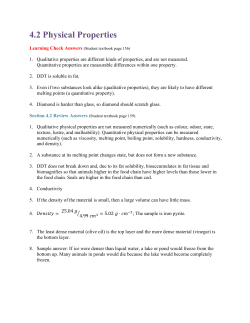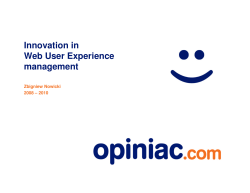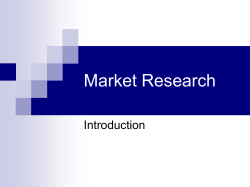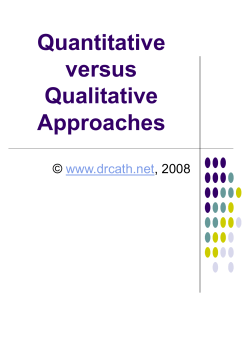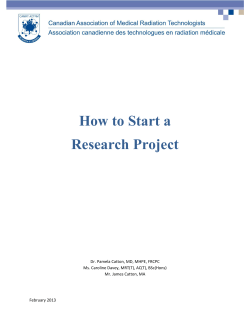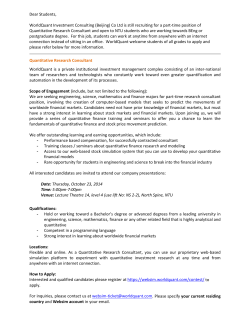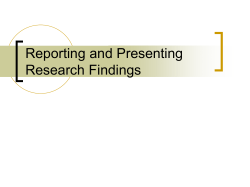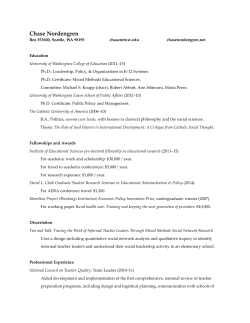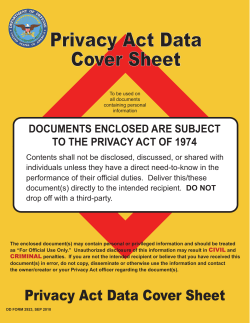
Never too small for research Neil Stollznow (QPMR) Director, Stollznow Research
Never too small for research Getting the most out of your research, and your budget Neil Stollznow (QPMR) Director, Stollznow Research National Secretary, AMSRS How to use market research in a SME environment The basics Qualitative Focus groups / group discussions In-depth interviewing Characteristics Unstructured Not representative Quantitative Telephone interviewing Intercept interviewing Online interviewing Door to door Characteristics Highly structured Projectable Sampling Questions When to use each approach Qualitative How do people feel What do they think What is their reaction to an idea Why do they behave this way Quantitative How many people feel this way How many think this way What is the size of the market for a new idea Before you begin… Define the issues Why you need to do research How will this information be used What do you need to know versus what is ‘nice to know’ What information do you already have What happens if I do nothing? Before you begin… How well do I really know my market? Age, income, occupation who purchase who don’t purchase where do they live… Beware “We know our customers/clients” Friends don’t tell you the bad things The brief Background to the project Business objectives you want to achieve Many people just state questions Researchers can help you define objectives Timeframe Budget No requirement to specify methodology Meet with the researchers Make sure they have your outlook Make sure they match your business What sort of budget do I need? How important is the issue? Qualitative What will it cost if we get it wrong? Focus groups $4,000 to $6,000 Costs affected by: Recruitment – easy / difficult Where the respondents are Quantitative Start @ $60 per interview (telephone) Economies of scale as sample increases Specialist techniques will cost more Tips for the perfect qualitative project Fish where the fish are Have realistic expectations about what people can tell you Don’t be proscriptive Participants must feel free to digress, argue and be involved Leave you with insight into Motivation Thoughts Perceptions Tips for the perfect quantitative project Based on real understanding of the population Ask questions people can answer Know the meaning of questions you’re asking Must have good sampling Sample size must be robust Confidence level Analysis of sub-groups Quality fieldwork Random in population If it’s not right at this stage it won’t improve! Quality analysis The right tools for the job What about the web Ideal for B2B Existing customers General population where income plays no role Issues 52% of Australian households have internet (ABS 2003) About 60% now Not equally distributed Older less likely to use Lower income much less likely to use The way of the future Use your existing data You have data! Data collection is the main cost of research Simple analysis is often overlooked Postcodes, spend, frequency You may have the resources internally Many consultancies can analyse data Use your existing data Complex analysis requires a specialist Loyalty programs Customer tracking Conducting internal research programs Any knowledge is better than no knowledge! A standard approach Identify key information requirements Systematically collect data Analyse the data Use existing business activities Use your CRM program Use your telesales information Things to remember Qualitative It is what it is Avoid jumping through hoops Projective techniques Extensive observation Extended groups (3 hours) ‘Homework’ Quantitative Doesn’t always need to be complex If cross tabulations are all that’s needed, that’s fine Ethics and quality Look for quality in suppliers as you do in your business Research Organisations Ethics mean people will speak (AMRO) to researchers Association of Market Australian Market & Social Research Society (AMSRS) AMSRS Code of Professional Behaviour Qualified Practising Market Researcher (QPMR) Interviewer Quality Control Australia (IQCA) Australian Standard 4752 Market research & telemarketing Must distinguish between the two activities Telemarketing sells Participants must understand which process they are involved in The individual is the focus Ethical behaviour Market research gathers Required by the Privacy Act information The individual is irrelevant to the project Participants must understand what their information will be used for Impact of the Privacy Act on market research More about databases than privacy National Privacy Principles (NPPs) Market and Social Research Privacy Code allows Collecting name and contact details Making recordings of research Using customer lists Registering individuals on a customer database Conducting fieldwork checks Contacting respondents for follow up research Case studies Inner-city hotel Upgrade worth $½ million Expanding restaurant Opening up former restaurant area to customers Who to cater for? What kind of food? What kind of ambience? Who lives in the area? Two-stage research program Quantitative 233 interviews Simple demographics Age Household makeup (share, family, couple etc) Household income Use of local hotels Opinion of local hotels Like to participate in group discussions? Two-stage research program Qualitative 3 group discussions Identified competitive set Identify strengths and weakness of each hotel What is missing in the area In food In recreation What should hotel food be? Menu evaluation Wine evaluation Role of promotions Role of entertainment Outcomes Understand local marketplace Things to do at the hotel …and things to avoid Demographics Competition Strengths Weaknesses Unique selling proposition (USP) Know how to develop profitably How to use every dollar in renovations and subsequent promotion to generate income Cost $13,000 + GST The British Council Who is the British Council? Cultural representatives Limited budget Primary means of communication is through website(s) Upgrading key site Essential for operation Information requirements Research needed to Content Relevance Information needs Branding on site Strengths and weaknesses Detail of the information on Retained information consider site Technical aspects Interactivity Ease of navigation Qualitative research 3 group discussions Completed with 3 key stakeholder groups Evaluated a draft-version of the website Participants took turns to navigate through the site while it was discussed Research outcomes Significant modifications made to site Specific direction on Links Quotes Graphics Content Summary of each page Important to ‘get it right’ first time when there is limited budget Cost of project was $12,000 + GST “Internet start-up” Can’t name Signed confidentiality agreement Needed to know Market size Likely market reaction to product Quantitative research Simple telephone interviewing Interviews last 5 minutes Asked about Scope of operations Size and number of activities Size and number of events Existing sales activities Likely uptake of offer Research outcome Small fractured market Large clients ‘signed up’ to alternatives ‘Rats and mice’ left Limited potential Idea killed Cost of project was $10,000 + GST Much less than would have been wasted on a idea that did not work What have we learnt? Key learning Know what you want to achieve before you start Find a company in tune with your business Prepare a brief Not as hard as it might seem Research does not require large budgets When to use Qualitative research Quantitative research Telephone interviewing Web research Don’t be afraid to complete simple research yourself The importance of standards and quality in consulting A simple checklist… To test if you’re on the right track.. Do you have the right sample / population? Do the research outcomes fit into your business plans? Is the methodology the right way to go? Don’t be bamboozled Methodology Process Do you have realistic goals Outcome Time-frame Do you understand the deliverables? Contact details Neil Stollznow PO Box 16 Level 2/156 Military Rd Neutral Bay NSW 2089 T +61 2 9953 7543 F +61 2 9953 7563 M +61 412 200 235 neil@stollznow.com.au www.stollznow.com.au
© Copyright 2025

